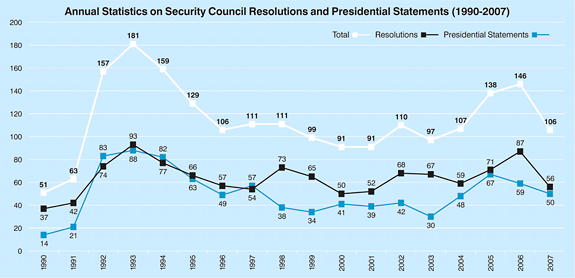Security Council Statistics for 2007
Security Council output fell significantly in 2007. The number of resolutions dropped from 87 to 56, while the total of presidential statements fell from 59 to 50. The combined figures represent a fall of 27 percent—or 40 fewer decisions in 2007 than in 2006.
The number of decisions does not necessarily mean a reduction in activity, however. To the contrary, the Council remained very busy in 2007, although some of the more intense activity did not result in agreed outcomes.
The number of Council meetings also dropped significantly. This is not surprising because of the high correlation between the convening of formal meetings and the level of prior agreement on outcomes. Interestingly, the number of meetings also fell by 27 percent.
Below is a chart that reproduces the statistics first published in our March 2007 Forecast report covering 2006 and which now includes data for 2007. (For additional statistics on Security Council activity in 2007, and comparisons with 2006, please click here.)

What is the story behind these statistics? In part, this represents some good news. When the figures are broken down to the country-specific level, it is clear that 50 percent of the fall in activity—twenty decisions—is related to just four country situations: Côte d’Ivoire, North Korea, Haitiand theDRC. In all four cases, reduced tensions led to a reduced need for Council attention. In the case of Haiti and DRC, the successful completion of elections in 2006 was a major factor.
But the other 50 percent is less easy to understand. It seems that the more troubled political dynamics in the Council in 2007 may be part of the explanation. The failed attempts to pass resolutions on Myanmar and Kosovo left legacies that resulted in an overall less cooperative atmosphere. And the Kosovo draft resolution consumed a huge amount of Council energy.
There was a big drop (from 12 to seven) in the number of Council decisions on Sudan. This represents 12.5 percent of the overall reduction in activity.
The total number of decisions on thematic issues fell from 26 to 23. But this figure conceals a much more dramatic fall in the number of thematic resolutions, down from 15 to five. It seems that political dynamics may explain part of this trend, particularly the apparent tendency to substitute thematic resolutions with presidential statements.
Another factor that may have influenced the totals was the concern by a number of members that too many draft presidential statements had little substance and were not going to influence events on the ground.
Possible contributing factors also include the fact that the two of the largest generators of draft Council decisions, France and the UK, had changes of political leadership in their capitals. And the change in leadership in the Secretariat in 2007 may also have played a role. The number of reports from the Secretary-General to the Council on country-specific issues dropped by 20 percent.
Another partial explanation is the fact that in 2006 there was an unusually high number of “technical” resolutions. These included ten “rollover” resolutions briefly extending mandates, whereas in 2007 the Council only needed to resort to this device on five occasions. Similarly, in 2006 there were four technical extensions of terms for ICTY and ICTR judges, whereas there was only one such resolution in 2007 (for the ICTY Prosecutor).
We should note that we also decided to test the hypothesis that the significant reduction in decisions in 2007 might have been offset by a shift to greater use of press statements. But while the number of Council press statements did rise slightly in 2007, it seems that 2006 had been a low year for press statements and that the 2007 figure was still below the average for the previous five years.
Click here for other SCR Reports on this issue.

